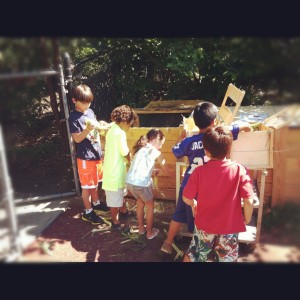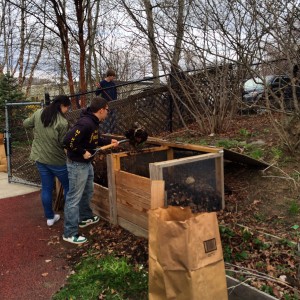Every good garden has a compost pile. It’s a place where magic happens. Where remnants of last year’s weeds, spent plants and tree leaves are transformed into a healthy soil amendment for the next year’s garden. These preschoolers are bringing their pea plants to be composted. Peas are finished for the summer, it’s too hot. Their vines will break down and add lots of good nutrients to our compost pile.
The composting project at Mount Kisco Child Care Center grew as a natural extension of our Feed Me Fresh seed to table food based curriculum. It helps demonstrate the circle of life: how waste becomes food. In this case, food for the soil. We also learn about how some things never break down, like plastic!
A parent volunteer built our three bin composting system outside near the kitchen and gardens which has been operational for three years so far. Children in the after school program bring buckets of vegetable scraps from the kitchen to the compost daily, they add carbon rich straw or leaves to balance out the nitrogen rich food scraps.
Toddlers and preschoolers collect food scraps in their classrooms from snack and cooking activities, they visit the compost bins, dump their scraps and have fun scooping leaves and/or straw with giant yellow leaf scoopers.
When bin #1 fills up with a mix of veggie scraps and straw/leaves, it’s time to get bigger helpers in to turn the compost. Last April, some high school volunteers from Horace Greeley’s Life School came and moved the compost along. The contents of bin #2 get moved into bin #3, and bin #1 moves into bin #2. By moving the compost to the next bin, you turn it all upside down, which stimulates the decomposition process.
It’s amazing to watch the compost heat up and shrink down in size. The whole process from start to finish takes a little more than 6 months. By making our own compost, we build fertility into our garden soil and we cut back on our waste stream.



